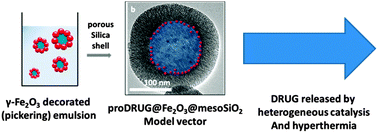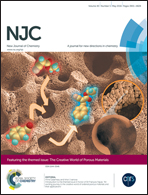Multifunctional core–shell hybrid nano-composites made using Pickering emulsions: a new design for therapeutic vectors†
Abstract
In this manuscript, we present a new strategy for the direct synthesis of functional nano-composite hybrid therapeutic vectors. The smart coupling of soft-chemistry and “ouzo effect” based emulsification processing allows us to create in a very simple way a Pickering stabilized emulsion from various prodrug modelling molecules used as a core, and subsequently embedded into a mesostructured silica shell. The resulting prodrug/Fe2O3/silica architecture offers a very good functionality/complexity ratio, realistic from a pharmaceutical development point of view at the industrial scale. While usual magnetic resonance imaging (MRI) contrast agent properties of maghemite nanoparticles are maintained, we proved for the first time that their smart localization at the organic/silica interface allows us to isolate them from phosphate anions of the surrounding environment, and thus to use their surface as a heterogeneous catalyst for controlled hydrolysis-mediated model drug delivery. This original hydrolysis-mediated release mechanism was investigated by grafting a model drug molecule via various covalent bonds. The release time can be tuned by this approach in between one hour and three days. In addition, magnetic radio frequency stimulation commonly used for hyperthermia treatment was able to accelerate the catalytic hydrolysis and release of the model drug by one order of magnitude, proving that drug release can be triggered on demand.

- This article is part of the themed collection: The Creative World of Porous Materials

 Please wait while we load your content...
Please wait while we load your content...